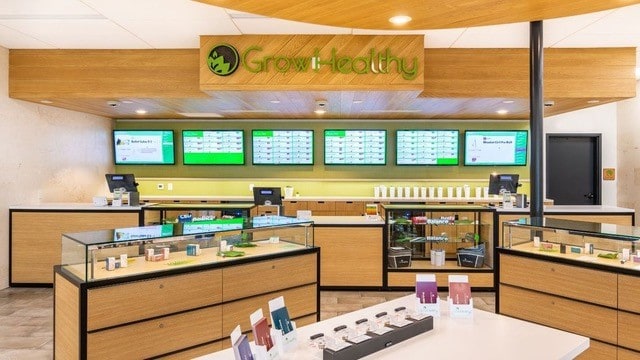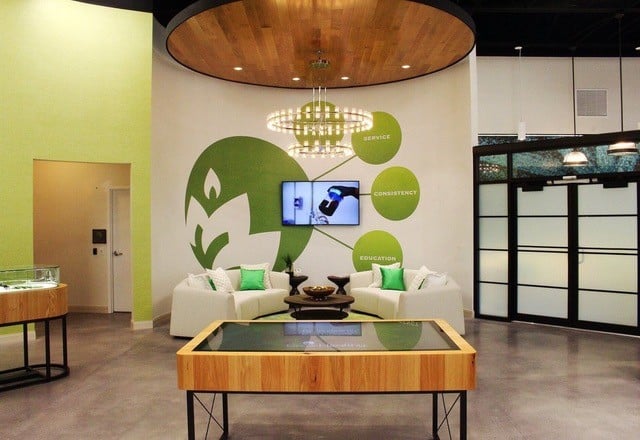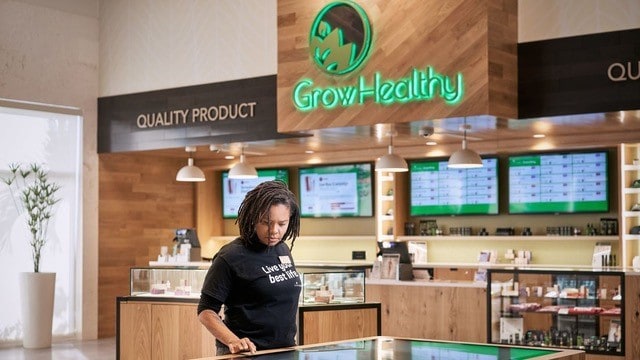GrowHealthy opened its first medical cannabis dispensary in West Palm Beach, Fla., at the end of 2018, and the company finished 2019 with 11 total retail outlets in the state, as well as a delivery service. With its twelfth dispensary opening last month and its plans to open eight more between now and July, the company is rapidly expanding throughout Florida while keeping quality high and internal communication flowing smoothly.
GrowHealthy is part of iAnthus Capital Holdings Inc., a multistate cannabis operator that owns multiple retail brands in Vermont, Massachusetts, New York, New Jersey, Maryland, Nevada, Arizona and Florida. Once the company opens the additional eight dispensaries in Florida this year, it will evaluate how many additional retail locations it should pursue in Florida in the second half of 2020 and in 2021, and where these locations should be positioned in the state.
“This state has been really welcoming to us,” Jeff Finnerty, GrowHealthy’s senior director of marketing and sales, tells Cannabis Dispensary. “Every geography we’ve gone into has been a success for us, and we couldn’t be more excited to be entering into eight new local markets in the next several months. We think that the future is bright, and that we can see the impact on patients and people’s lives, and that’s the most rewarding part of the whole thing, that people are finding solutions to their illnesses and symptoms that they haven’t been able to find in years. This is opening up avenues to better lives for a lot of people.”
Here, Finnerty shares retail expansion tips for cannabis dispensaries, based on best practices that have worked for the GrowHealthy team as it continues to expand throughout Florida’s market.

1. Be deliberate when scaling up.
Before a company can even think about expanding, it must have a clear and attainable mission that can then be applied to new locations and operations.
“I think from an expansion standpoint, it is just starting with your core mission and making sure that you can execute that at a high level,” he says. “For us, that’s creating and curating the best natural medicine that we can possibly do, and then creating a store environment that is not intimidating, that is very approachable and comfortable, and then staffing people who are passionate about helping others and empathetic. And once you get that right, you use that to find your next opportunity. You’ve got to walk before you can run.”
Companies looking to expand should allow experienced employees from the oldest and best-performing stores to advance to new locations so they can share their expertise, Finnerty adds. This ensures that knowledge and best practices flow from store to store, he says, which helps maintain consistency as the company grows.
“There is a lot of excitement in the industry,” he says. “It’s exploding, but I think it’s really important, if you’re going to grow, to do it very deliberately and with a focus on your mission and who you want to be. As quickly as the opportunity seemed to arise, don’t ever lose sight of that because you’ll lose control and the message will change and the experience for the patient will change. And once you’ve lost that consistency, it’s hard to get that back.”
GrowHealthy is required to be vertically integrated under Florida law, and it has an operating committee comprised of top executives to ensure that all areas of the supply chain scale up together.
“We’ve got a 33-acre facility … with eight different buildings on the property,” Finnerty says. “As we build out each of those buildings to turn them into fully functional flowering bays—vegetation, greenhouse, all of those things—we have to make sure that we’re scaling at the same time to produce the correct amount of products to properly supply the new stores we’re rolling out. We would never want to go into a new market and … supply that new store so patients at other stores no longer have access to the same medicine we were offering before or come into a new market and not have our full breadth of products. We make sure we’re in alignment and … when we see opportunities to expand the grow, that we’re doing it in a smart way.”
The company is building out its facilities according to FDA standards that regulate the food manufacturing process to help protect safety, quality and patient trust at each new location, he adds.
2. Use a tried-and-true way to identify potential new locations.
When identifying potential new locations for a dispensary, companies should have a consistent strategy to evaluate each area and find the best fit. The GrowHealthy team, for example, looks at a combination of population density and medical cannabis adoption rate, which is data published by the Florida Office of Medical Marijuana Use.
“You might have one county that has 100,000 people and another county that has 80,000 people, but the county with 80,000 people has an adoption rate of 5% or 6% and those people are getting their marijuana cards, and the other county with 100,000 people might be at 1%,” Finnerty says. “We focus on those areas that have very high adoption rates.”
The company also evaluates real estate opportunities that arise, as well as the competition in a particular area.
“We’ve gone into markets where we’re one of the first three dispensaries to come to the market [and] we’ve gone to markets where there might already be nine or 10 dispensary brands there,” Finnerty says. “We’re about to go into Tallahassee shortly. There are already 10 of our competitors there, but we feel it’ll be a strong market for us, so we made that decision.”

3. Build a diverse team that can learn from one another.
When building its retail team, GrowHealthy makes hiring decisions based on diversity of thought and experience, Finnerty says, to allow employees to learn from one another’s strengths.
“We’re pulling people in from different industries, as well as people from the cannabis industry, to blend those teams and create shared learning and the best possible experience for our patients,” he says.
GrowHealthy’s store managers come from backgrounds in high-end retail, nursing and science, for example, and Finnerty believes building a diverse team across stores helps to create those shared learnings.
The retail teams working in each of the company’s dispensaries are also reflective of the local community, he adds. “You’ll see a different set of folks in our North Miami store than you’d see in Pensacola, and that’s a reflection of the geography and the community that we’re serving.”
4. Form strong relationships with the community—especially local certifying physicians.
The GrowHealthy team approaches marketing from a few different angles, Finnerty says, but one of its most effective strategies is allowing the sales team to connect with the local physicians and clinics that certify patients in any given area.
“There are roughly 2,600 physicians in the state of Florida that have been authorized by the state … to write these recommendations or certifications for cards,” Finnerty says. “We know that any time a new patient [enters] the medical market, they have to go to one of those doctor’s offices, so our medical sales teams work closely with the physicians in each geography. We keep them up to date on our products [and] our educational materials. Sometimes, we’re educating physicians on medical cannabis products. It’s not part of the medical school curriculum, so we’re able to help steer them toward continuing education for themselves, but also … getting their feedback on, what other information do patients need that we can help provide as a dispensary and as a partner to those physicians?”
GrowHealthy places an emphasis on safety over sales and developing these relationships with certifying physicians helps the physicians feel comfortable recommending a GrowHealthy dispensary to their patients, he adds.
“We also engage in community marketing,” Finnerty says. “We try to find veterans groups and other types of community groups in the area, let them know we’re coming and educate them on who we are. We use traditional digital marketing tools like social media and our email and text campaigns, and we engage with our PR firm … and they help get the word out through news and print and help us create some excitement around the new geographies, as well.”

5. Select products based on consumer preferences when possible.
Because GrowHealthy is vertically integrated, the company can only sell its own products at its retail locations, which can limit product selection, Finnerty says.
“We have a smaller array of options because everything we sell within the retail environment is grown [by us], and that is a very important process as far as how we expand,” he says. “Our retail growth has to be tied to expansion and development with our manufacturing facilities and our supply chain. It’s important that all those things work together for us to put our best foot forward whenever we go into a new market. What you’ll see currently is the same array of products in each dispensary. We’re getting better at understanding that there are preferences.”
GrowHealthy has determined that its West Palm Beach store sells more vape cartridges than other stores, for example, and the team now ensures that that particular store has the widest variety and highest volume of carts available, Finnerty says. The company’s Brandon store sells the most flower, he adds, and so the team routes product accordingly.
“A lot of that work is done by engaging our consumers and asking what is important to them, but also, our medical sales team is a big part of that, engaging physicians in the state to understand which products, from a medical standpoint, make the most sense for us to develop,” Finnerty says. “Recently, we’ve launched capsules, which is an important product to have because a lot of patients who are transitioning for pain from maybe more typical pain medication, they’re used to that format, being able to take a pill, and the dosing is easy.”
GrowHealthy also recently launched Rick Simpson Oil (RSO), which offers a full spectrum effect, similar to flower, and which can be used to treat the symptoms of cancer and cancer treatment, Finnerty says.
“It’s ingestible, and it’s been a really big hit for us over the past week or so,” he says. “We got terrific feedback from the patient community as well as the physician community.”
6. Maintain open lines of communication.
Keeping communication flowing smoothly is critical when expanding, Finnerty says, especially in a larger state like Florida.
GrowHealthy has multiple regional operations managers who interact with each of its store managers on a regular basis, he says, and a member of the marketing team regularly interacts with each of the store managers to ensure that messaging for patients and physicians is consistent across the state.
“Then, we have liaisons from our manufacturing and product development teams who are constantly having those conversations with the retail team and the patient care representatives in the call center, so that they have the best knowledge around our products,” Finnerty adds.
The company is also in the process of launching an intranet, a platform where all of its retail associates can interact with other departments.
“It’s really going to help us with our communication and our ability to disseminate information, once we get that launched,” Finnerty says.

